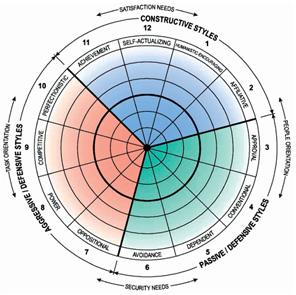 The Level I: Life Style Inventory (LSI) was originally developed by J. Clayton Lafferty in 1973. The Level I: LSI is described as a self-assessment of 12 different thinking and behavioral styles of interest to members of work organizations. This form of the LSI has a total of 240 items, with 20 items assessing each of the 12 thinking and behavioral styles. The responses range from 0 (essentially unlike you) to 2 (strongly like you—most of the time). This inventory has been used by career counselors to assess the relative emphasis a client places on work-related cognitive and behavioral styles. This instrument is also employed by management consultants to enhance the performance of groups by providing a method of assessing and selecting leaders based on their interpersonal orientations. Furthermore, the Level I: LSI has been used to perform a longitudinal assessment of beneficial attitudinal change in students enrolled in a professional master’s program in managerial leadership.
The Level I: Life Style Inventory (LSI) was originally developed by J. Clayton Lafferty in 1973. The Level I: LSI is described as a self-assessment of 12 different thinking and behavioral styles of interest to members of work organizations. This form of the LSI has a total of 240 items, with 20 items assessing each of the 12 thinking and behavioral styles. The responses range from 0 (essentially unlike you) to 2 (strongly like you—most of the time). This inventory has been used by career counselors to assess the relative emphasis a client places on work-related cognitive and behavioral styles. This instrument is also employed by management consultants to enhance the performance of groups by providing a method of assessing and selecting leaders based on their interpersonal orientations. Furthermore, the Level I: LSI has been used to perform a longitudinal assessment of beneficial attitudinal change in students enrolled in a professional master’s program in managerial leadership.
Lafferty theorized that there are 12 lifestyles and based the development of his instrument on Abraham Maslow’s hierarchy of needs as well as on the views of other needs theorists and psychologists. Instead of using Maslow’s proposal that needs are organized hierarchically, Lafferty theorized that his 12 lifestyles formed a circumplex; thus, the hypothetical structure could be construed as a circular ordering of the variables, similar to the way in which hours are positioned on a clock. The variables were ordered as follows: Humanistic/Helpful was found at 1 o’clock, followed by Affiliative, Approval, Conventional, Dependence, Apprehension, Oppositional, Power, Competitive, Perfectionist, Achievement, and, finally, Self-Actualization at the 12 o’clock position. The lifestyles placed adjacent to each other are considered to be highly related. More recent studies have demonstrated that the 12 scales load on three factors: people/ security, satisfaction, and task/security orientations.
In 1976, Lafferty developed the Level II version of the LSI: Description by Others, a parallel inventory allowing four to five other individuals to assess the individual of interest with reference to the same 12 thinking and behavioral styles. Lafferty developed this second inventory to respond to findings that people may confound self-perceptions with an idealized style of thinking and behaviors; in other words, people tend to report that they act in the way that they feel they “should” act, rather than report their actual behavior. The Level II: LSI allows for the individual of interest to receive feedback from others, making available to the individual information about how his or her behavior is perceived by others. As a result, the individual can compare his or her intentions with the perceptions of others. When used for the purpose of management training and development, feedback generated from the Level II form adds an important dimension to the information provided by the Level I form. This feedback from coworkers and subordinates can provide individuals with insights regarding the inferences made by others pertaining to their thinking and behavioral styles.
See also:
References:
- Cooke, R. A., Rousseau, D. M. and Lafferty, J. C. 1987. “Thinking and Behavioral Styles: Consistency between Self-description and Descriptions by Others.” Educational and Psychological Measurement 47:815-823.
- Lafferty, J. C. 1973. Human Synergistics Evaluation System Level I: Life Styles. Plymouth, MI: Human Synergistics.
- Levin, J. 1991. “The Circumplex Pattern of the Life Styles Inventory: A Reanalysis.” Educational and Psychological Measurement 51:567-572.
